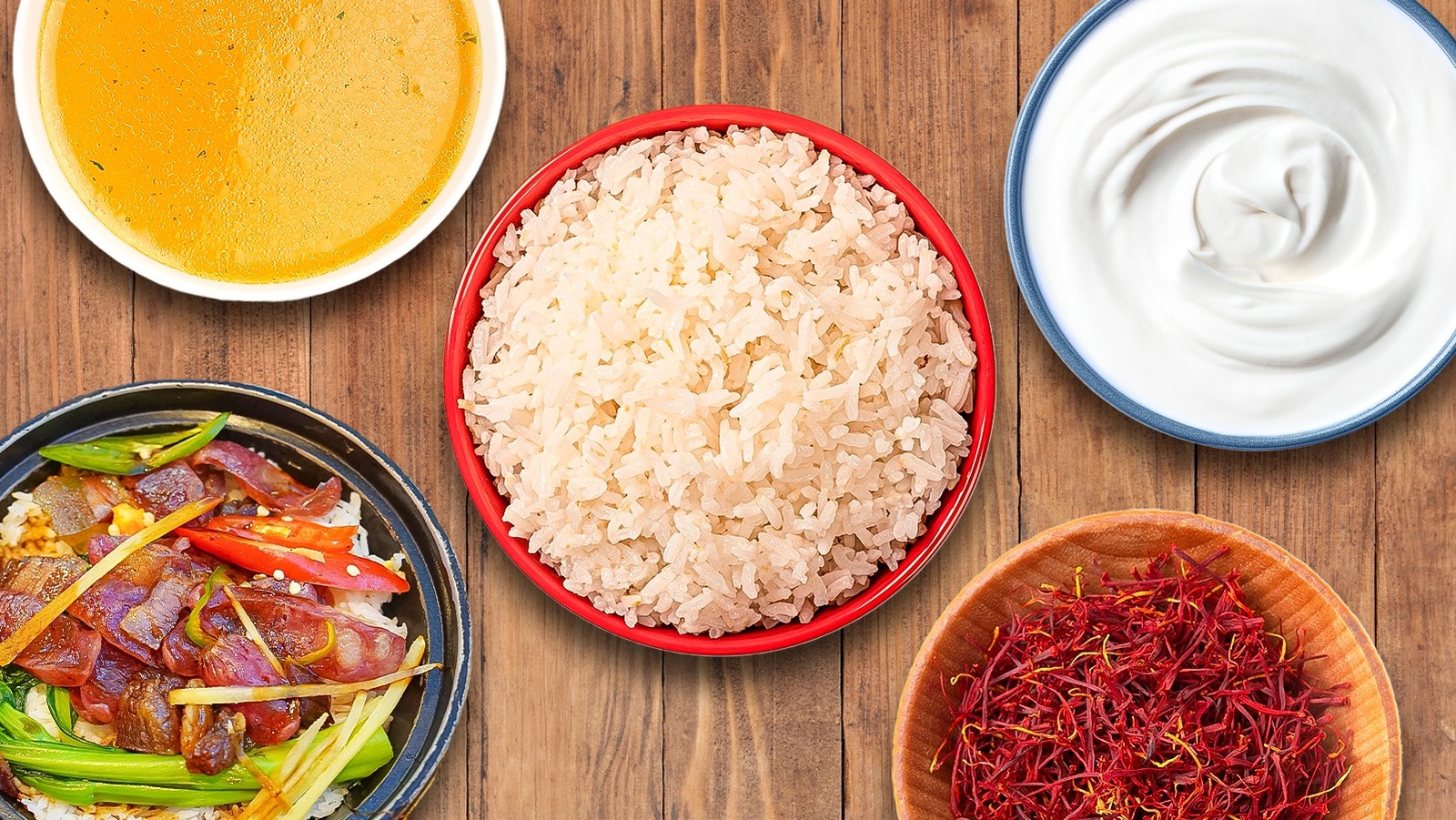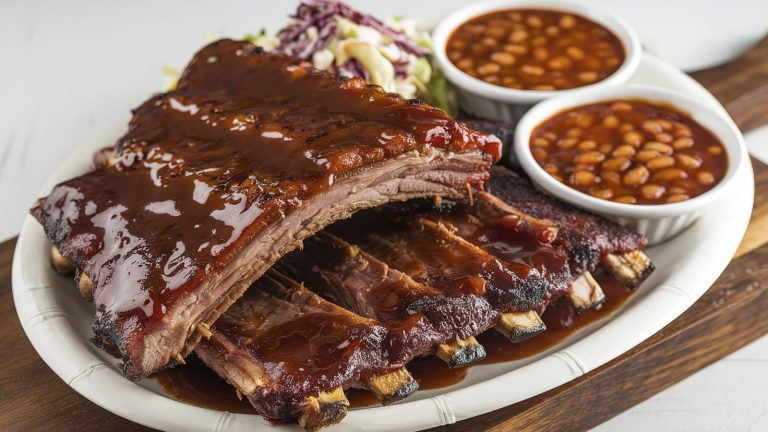In some parts of the world, a meal without rice is unthinkable. In Chinese and other East Asian languages, the standard greeting upon meeting someone is not “How are you?” but “Have you eaten rice yet?” People in rice-centric cultures appreciate the humble grain’s versatility –- growing up in a Chinese-American family, I enjoyed, and still enjoy, rice in dozens of guises: Cooked plain, it’s a satisfying backdrop to strongly flavored stir-fries and curries. Ground into flour, it makes a vast range of chewy treats, from noodles to sweet confections such as light, chewy mochi doughnuts.
But if rice is just a once-in-a-while thing for you, thinking of creative things to do with it can be a struggle. There are times when you want rice to go with your meal, but plain boiled rice just won’t cut it, and more complicated rice dishes, such as fried rice, may be overkill. Fortunately, rice absorbs flavors like a sponge, so it doesn’t take much to transform plain rice into something tasty and interesting. Here are some easy tweaks to elevate your rice –- and best of all, they’re all simple enough to throw together on a busy weeknight.
Switch out the water for meat or poultry stock
At its simplest, a pot of rice requires just two ingredients: raw rice and water to cook it in. Ideally, the end result should be a big portion of tender, but not mushy, grains. Though many love the delicate aroma of plain cooked rice, it doesn’t taste like much on its own -– but its plainness makes it a perfect accompaniment to saucy dishes.
But if you’ve already planned for a simple, sauce-less main dish — such as a basic roasted chicken recipe or grilled chops — you probably want a side with a bit more oomph. A super-simple way to give rice a bit of extra color and flavor with almost no additional work is to cook it in broth instead of water: Use the same amount of broth as you’d use for water, and cook as usual. The only extra step is to open a can of broth.
In case you’re wondering how much liquid to use, here’s a traditional Chinese technique: Put rinsed, raw rice in a cooking pot and place the tip of your index finger on the top of the rice. Pour over your cooking liquid, in this case broth, until it reaches the first knuckle of your index finger. Cook uncovered over medium heat until the liquid is absorbed; then cover and turn off the heat. Let it sit until the rice is tender, about three minutes.
Sauté leftover rice with garlic
For some home cooks, leftover plain rice feels like a guest who’s overstayed their visit. It was pleasant the first time around, but a few days later, it just seems boring –- what are you supposed to do with it? The solution here is to look to rice-eating cultures, who’ve figured out that leftover rice is a culinary secret weapon. To make the best fried rice, for example, you must start with cold, cooked rice. This is why many Asian households intentionally cook enough rice to have some left over for future use. Another reason to embrace cold, leftover rice is that it’s less caloric than fresh, hot rice: Cooling transforms some of the rice’s starch into so-called resistant starch, which resists being metabolized into glucose in the bloodstream.
The good news is the resistant starch persists even if the rice is reheated. This brings us to a traditional Filipino hack to transform leftover rice into a treat: Sauté cold rice with oil, salt, and a generous dose of minced garlic (more is always better). Start by heating oil in a frying pan, add the garlic and salt and cook until fragrant, then stir in the rice and toss until it’s heated through and permeated with garlic. It’s great with both saucy dishes and simple cooked meats.
Toss in a Chinese sausage before cooking
Around the world, cooks have devised memorable rice dishes by simmering or baking raw rice with other flavorful ingredients. As these ingredients simmer in the cooking liquid, they release their aromatic juices and oils, which the rice absorbs. Examples of such dishes are the are the Latin American classic arroz con pollo, in which chicken, spices, and aromatics are simmered or baked with rice. Chinese clay pot chicken rice employs the same principles, but with distinctively Asian flavorings, such as ginger and dried mushrooms.
These, of course, are main-course dishes that require main-course levels of preparation and attention. But you can also transform plain rice into a flavorful side or light meal simply by adding one ingredient: a whole or sliced dried Chinese sausage (lop cheung). These chewy, sweet-savory sausages have a distinctive spiced flavor that pairs wonderfully with rice and adds a pretty pop of color. All you have to do is plop the sausage on top of the rice before you add the cooking liquid and cook as usual. (It even works in a rice cooker.)
Stir in yogurt and spices
A fun thing about rice is you can take it in virtually any flavor direction. For a creamy, flavorful side dish, try a South Indian classic: yogurt rice, also known as curd rice. It’s simply cooked basmati rice with plain yogurt and gently fried spices stirred in. Cooks also add flavor-boosting ingredients, such as coconut, or chopped vegetables, like cucumbers and onions. Don’t expect it to be hot, either, in terms of chili heat or temperature –- because cold yogurt is stirred into cooled rice, it’s closer to room temperature than just-off-the-stove hot.
Because yogurt rice is served cool, it’s most popular in the summer –- Indian tradition holds that yogurt brings down body temperatures, so it’s considered to be a healthy food for hot days. This wholesome, soothing dish (without the spices) is also a gateway solid food for babies in South India, where moms whirl cooked rice and yogurt in a blender for them. It’s also commonly served at the end of a meal to aid digestion. To ensure your yogurt rice has a soft, comforting texture, ensure your rice is fully cooked before you add the yogurt, since the cool yogurt hardens the cooked rice grains.
Sprinkle in saffron
In many parts of the world, eaters appreciate rice as an indispensable staple. In some countries in Africa and Southeast Asia, it comprises 60% of the average daily calorie intake for most people, and in Bangladesh, it comprises a whopping 70%. This suggests that even when pricier foods, such as meat, may be out of reach or in short supply, one can count on a bowl of rice for sustenance. But while rice is often seen as a lifeline for the poor and an everyday meal stretcher for working and middle-class families, it can also be the centerpiece of a high-end celebration. A caterer in India, for instance, pampers his wealthy clients with cooked rice garnished with sheets of 24-karat edible gold leaf.
While eye-catching, this bling adds nothing to the flavor of the rice. But for a celebration meal, you can add other, more flavorful luxury ingredients to your rice. For instance, saffron –- the handpicked, dried stigmata of a type of crocus –- adds not only a sunny yellow color to your rice, but a distinctive flavor as well. While saffron is a splurge, you don’t need very much of it: Just grind up a few strands, soak them in a few spoonsful of water to release their color and aroma, and incorporate them into your rice before cooking.
Simmer rice with dried fish
To the uninitiated, some traditional Asian ingredients may seem off-putting on their own. Take Chinese dried fish: A staple in South Chinese cooking, it’s heavily salted, seriously fishy smelling, and tough, an artifact of the days when fishermen salted and sun-dried fish to extend its shelf life. But just as you wouldn’t think to chew on a cinnamon stick as a snack, you’re not meant to eat dried fish straight from the package. Rather, cooks incorporate small portions of it into cooked dishes to add a deep umami punch.
For instance, flakes of dried fish make a flavorful addition to main-course rice dishes, such as fried rice. But an even simpler way to enjoy it is to do as my mom often did: Cook the rice the way you normally do, but toss in a few pieces of dried fish. The salty, savory flavor will permeate the rice, and the little bits of fish will add salty pops of flavor. It’s great as a side dish or even as a simple late-night supper.
Add pureed tomatoes to the cooking liquid
Most people don’t give much thought to the pretty red rice that shows up with refried beans next to your meals at Mexican restaurants, but they still eat it all up, and would likely protest if it weren’t there. This unsung side dish gets its color and much of its flavor from pureed tomatoes, along with aromatics like onions, garlic, and chilies. Indian cooks make their own version of tomato rice, which uses the same basic ingredients, but adds spices including ginger, turmeric, and garam masala.
No matter which version you make, the fundamentals are the same: You start with pureed fresh or canned tomatoes, seasoned as you desire, then add your cooking liquid to raw rice, and cook. The rice absorbs the tomato-infused liquid and turns a pretty red. If you find plain rice boring or want a flavorful and colorful side dish to liven up a simple main course, tomato rice is a time-tested solution everyone will enjoy.
Transform cold rice into a rice salad
Cooked rice is much more versatile than you may think. Not only can it assume a number of flavors and textures, it doesn’t even have to be served hot. Besides creamy, sweet rice pudding, which is tasty straight from the refrigerator, you can also enjoy cold cooked rice as a refreshing salad! You can think of it as a pasta salad with rice in the place of the pasta.
Like pasta salad, rice salad has endless possible variations. One of my aunts made a flavorful version with brown rice, raisins, toasted sunflower seeds, and a tangy curry dressing. Another version I had in France included white rice, flaked tuna, corn, tomatoes, scallions, and diced bell peppers with a light vinaigrette. Other versions take it in a Mediterranean direction with cucumbers, olives, and tomatoes. In short, rice salad can be anything you want it to be –- all you need is some leftover rice and a bit of imagination.
Stir an egg into hot rice for richness
Just as eggs and bread are natural partners on Western breakfast tables, eggs and rice are a favorite pairing for simple meals in Asian cuisines. Fried rice with bits of scrambled egg is a familiar example. In Korea, a favorite comfort food is a bowl of hot, buttered rice topped with a lightly fried egg and garnished with soy sauce, sesame oil, and scallions. The runny yolk mixes with the soy and sesame oil, forming a flavorful sauce for the rice.
Even simpler is the cozy Japanese dish, tamago kake gohan –- you don’t even need to fry the egg. Instead, you crack a raw egg over a bowl of steaming hot rice, add a few drops of soy sauce, and whip the whole thing together vigorously with chopsticks. The heat of the rice cooks the egg slightly so it forms a rich, gooey sauce that coats the rice. For extra flavor and color, you can top it with a sprinkle of furikake, a savory Japanese condiment of dried seaweed shreds, sesame seeds, and other flavorful ingredients. If you’re concerned about the safety of raw eggs, use pasteurized eggs –- or pasteurize them yourself in a 135 degree sous vide bath for 2 hours.
Toast rice in butter for a nutty flavor
It’s no secret that butter makes everything better, including rice. Plenty of recipes call for butter to be stirred into hot cooked rice before it’s served, and it’s easy to see how that would add richness and flavor. Even plain, unseasoned rice transforms into something special with just the addition of a generous portion of butter.
But if you seriously love butter, you know it gets even better when it’s gently browned. Browning brings out nutty, toasty notes that seem to amplify its richness. To incorporate these flavors into rice, just fry your rinsed, raw rice in butter until it (and the butter) start to look toasted and golden, then add salt and cooking liquid (broth is a good choice here) and cook as usual. Be aware, however, that butter can go from pleasantly browned to burnt in a heartbeat, so monitor your pan and your heat closely during the frying stage.
Cook with toasted vermicelli for a pretty pilaf
At Middle Eastern restaurants, you may encounter fluffy cooked rice strewn with skinny segments of cooked vermicelli. Numerous variations of this dish exist, but most follow the same general principles: Brown short segments of vermicelli (or angel hair pasta, if Middle Eastern vermicelli isn’t available) in butter, add rinsed raw rice, flavorings, and cooking liquid, then simmer until done.
It’s a pretty as well as tasty dish, with the browned vermicelli adding a fun contrast in flavor, texture, and color. If you’re feeling creative, it lends itself to a range of possible add-ins. Sautéed onions and garlic add extra depth and savoriness, and a handful of toasted pine nuts stirred in after cooking can add a nice crunch. Some cooks also add flavor by cooking the rice and toasted vermicelli in broth rather than water. It’s great paired with grilled meats, but it’s also mild and neutral enough to complement rich stews.
Add coconut milk to your cooking liquid
A fundamental principle of cooking rice around the world is to flavor rice with whatever you happen to have around. In Mexico, it may be tomatoes and chiles, while in Japan, it may be soy sauce. In Southeast Asian countries, such as Thailand and Malaysia, cooks rely on a locally common liquid to add richness and flavor to their rice: coconut milk.
Rice cooked with coconut milk may look like plain, boiled rice, but don’t be fooled – the coconut flavor comes through loud and clear. Also, don’t be tempted to simply use coconut milk in place of water when cooking your rice: Because coconut milk is so much thicker than water, rice can’t absorb it as easily. In addition, the solids in coconut milk can also cause scorching on the bottom of the pot. To prevent these problems, soak the rice in cold water before cooking to help it absorb the cooking liquid more easily, and dilute the coconut milk with an equal amount of water. Don’t worry that this will dilute the coconut flavor –- it’ll definitely be there when the rice is cooked. As you may expect, coconut rice goes well with any Southeast Asian or tropical cuisine –- try it with jerked chicken or Thai or Indian curries.




